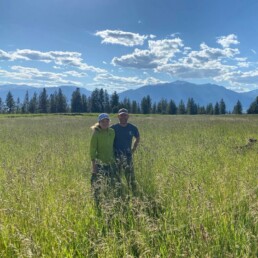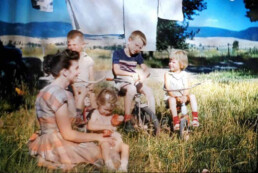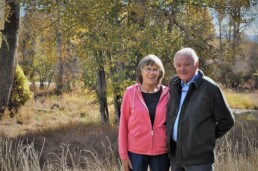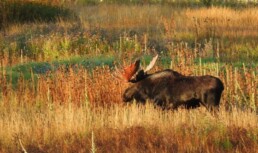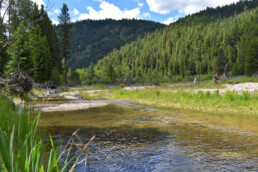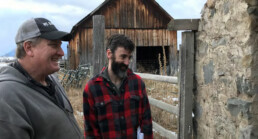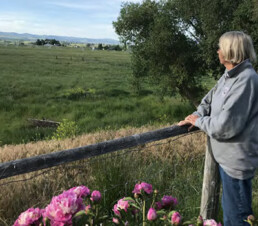Back to the Beginning: Conserving an Enchanting Bitterroot Valley Ranch
The Bitterroot Valley draws people from all walks of life – each with their own backstory, passions, and unique reasons for calling this special place, “home.” But one commonality is prevalent across community members: a love for open space.
Gary Beadle was born and raised on a farm in the Midwest. He grew up learning to love everything that the farming lifestyle had to offer. When it came time for him to head out on his own, he landed in an urban area, with a career that placed him on the inside of an office – a complete opposite landscape from what he had always known.
“When I first met my husband Gary, he couldn’t have been doing anything different than how he grew up – always dressed for work in white shirt and trousers,” says Robin Beadle. “But I knew he was a farmer from his past and loved hearing the stories he would tell me from life on the farm. I was enchanted by it – and that my husband had that value system of understanding the importance of agriculture, growing your own food and hard work. We felt we needed to move elsewhere to get back to those roots.”
After feeling an instant connection to the Bitterroot during a trip in the early 2000’s, they decided to jump in with both feet and were able to purchase acreage in Victor, which they dubbed “Rory R Ranch.” During their early years in the valley, Gary and Robin quickly observed how the valley was changing. It concerned them.
“Coming from a large urban area like Chicago, over those 40 years, I saw such an explosion of suburban development with people purchasing all of this valuable agricultural land in Illinois and seeing it be divided into subdivision after subdivision,” says Gary. “I knew if there was going to be this heightened level of development in Ravalli County, that preserving the ag land would be critical.”
When a large ranch went up for sale west of Stevensville in the Burnt Fork neighborhood, the Beadles jumped at the opportunity to protect it from subdivision. Formerly known as the Mytty Ranch, they purchased a significant portion of it and instantly started to discuss the next steps, which would be to preserve the property for the future of agriculture in the valley.
“As soon as we bought the ranch in Stevensville, things really started to blow up here with land prices skyrocketing and more and more people moving to the valley,” says Robin. “The timing was perfect when we started talking with the Bitter Root Land Trust about the easement. It was almost meant to be.”
The Beadles were both very familiar with the concept of land conservation and the conservation easement tool when they began meeting with the land trust. It was something that they had been interested in doing from the very beginning with their Victor ranch, and what drove them to ultimately purchase the Stevensville ranch. After conservation staff visited the property, there was no doubt that this project would be a perfect model for a conservation easement.
The property is comprised of two large tracts of land totaling 1,260 acres of open-space rangeland that includes sagebrush shrublands and montane grasslands, along with miles of ephemeral creeks and riparian habitat, all of which collectively support locally important species such as elk, mule deer, white-tailed deer, and fox, and “Species of Concern” such as Brewer’s sparrow, evening grosbeak and sage thrasher. The shrublands and grasslands provide grazing opportunities for cattle, as well as scenic views of natural open space that can be enjoyed by the public traveling along a number of significant valley roadways.
“I know personally when I go to the larger grassland parcel, I can go up there and just get lost,” says Gary. “You look around, and it’s just amazing to look to the west and to the north, the south and the east, and all you see are mountains, grassland, and wildlife. It’s as if you’re in the middle of heaven. No structures, no people – just wildlife and natural beauty.”
And now, thanks to critical funding support from the Natural Resources Conservation Service’s Agricultural Land Easement Program and the Ravalli County Open Lands Bond, 1,260 acres of the ranch are conserved.
“We’re just so happy that we were able to put this property in an easement and preserve it for future generations,” says Robin. “People move here with different intentions. This is a special place, and if we don’t reasonably protect it, it will be gone. We just want to keep it this way the best we can, forever.”
Honoring the Past for the Benefit of Tomorrow
When Carola (Carol) Woolsey-Mielke’s parents Vernon and Maria Woolsey first started leasing the ground that is known today as Haywire Flats in 1948, the property consisted largely of sagebrush. They started working to clear off the bench area and, after many late nights and weekends with the help of their family, transformed the land into productive farmland which would eventually come to produce wheat, barley, and oats. The Woolsey family purchased the ranch in 1959 and it has remained in Carol’s family ever since, owned today by she and her husband Ed.
After Vernon passed away in 2006, the property was not used for agriculture again until several years later when Carol and Ed’s son-in-law Lance Brown expressed interest in farming the land. Unfortunately, with the shape it was in, it wouldn’t be that easy.
Since the ground was last farmed, the sagebrush had grown back and inched its way back onto the property. Bull thistles and other aggressive weeds had taken over. Fences were in bad condition, with a majority having to be replaced. It took time and energy to revive the ground, but eventually the family was able to get the job done.

“In respect for all the hard work my mom and dad did on this land, we figured out a plan to reclaim the bench property and were able to turn it back into usable land again,” says Carol. “Just as my dad would have wanted.”
After turning the soil, piling, and burning piles of sage, wheat was able to be planted once again. Sine that time, the property has been continually sprayed for weeds, and the sagebrush burned to keep it from infringing back onto the property. The property carries up to 40 pairs of cows and calves each year during the summer, leaving ample grazing for elk and mule deer and open space for other wildlife that frequent the property in the winter months.
“This piece of beautiful Bitterroot Land has always been a part of my life. My mother and father instilled in me the love of the land – especially the Sapphire Mountains. My mom was a Holocaust survivor, and she was very much into the land and that it was your responsibility to take care of it.”
And, by making the decision to place the 258-acre Haywire Flats into a conservation easement, the Mielkes have taken care of the property and its future, forever. The Haywire Flats property was the last piece of the puzzle that created a 7,150-acre contiguous link of open land preserved by numerous landowners in the Burnt Fork neighborhood for wildlife, agriculture and future generations that begins on the foothills of the Sapphire Mountains and runs to Logan Lane on the outskirts of Stevensville.

“When I was growing up, my dad and I would go ride the fences and check cows. We always ate our lunch in the shade of a huge old juniper tree, with Slocum Creek running close by. My dad would tell stories of growing up in the Bitterroot, and we would talk about life in general.”
In 2011, Carol and Ed hand-built a small dry cabin in that exact spot where they gather with their kids and grandkids often.
“It always seems that Dad is very close when I spend time there.”
Thanks to the decision of Carol and Ed and their family to honor past generations by preserving this beautiful piece of the Bitterroot, future generations will continue to benefit from this open space.
A Decision That Inspires
Perched just to the south of the Burnt Fork drainage in Stevensville, where more than 7,000 acres of working lands have been conserved over the last decade by local families in partnership with BRLT, sits Sunset Bench – a natural, long section of prime agricultural land and wildlife habitat with steep slopes leading to the green valley below.
Landowners Mike Sylvester and Meghan Hanson look around at the ground they protected through a conservation easement in 2019 in partnership with BRLT and think about what might have been – which, more than likely, would have been a subdivision. With panoramic mountain views of the Bitterroot and Sapphire Mountain ranges, this piece of land was ripe for development. The property was subdivided into 13 different lots, complete with septic, wells, and underground electric.
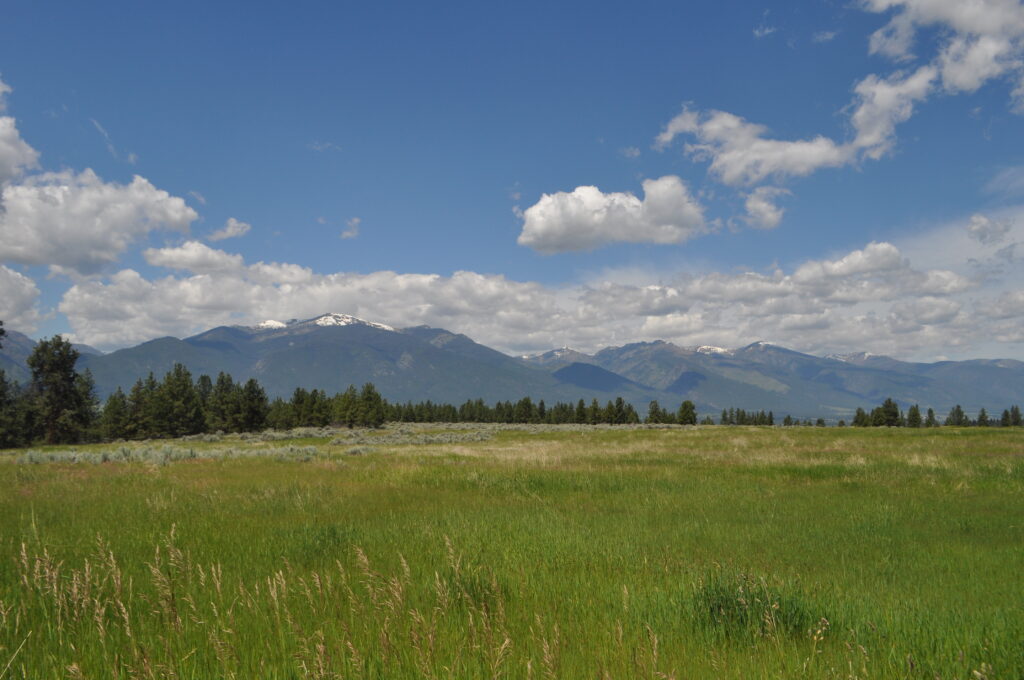
“This is the right thing to do,” says Mike. “Other parts of the country have already changed so much. To have these open spaces is amazing.”
With conservation values including a mix of agriculture, ponderosa pine forest (with a year-round spring for wildlife) and open sage fields, Mike and Meghan saw a brighter, more open future for the land which serves as a secluded haven for wildlife.
When it came time for Mike and Meghan to consider building a residence on the property, they agreed they wanted to have as low of an impact on the land as possible. As such, they planned for a net zero small house on the edge of the property – the first in Montana to be certified Passive House through PHIUS (read more about the design here). They sited the home on an area previously disturbed as a riding area with storage sheds nearby that have been repurposed as a garden shed and a bunk house.
“This home is 5.5 miles away from where I was born and spent the first 17 years of my life,” says Meghan. “Having moved away I returned back to this piece of land so spectacular it required that a home here be integrated into and take nothing from it.”
Through working with BRLT to place a conservation easement on the property, the character of the property, as well as Sunset Bench and the surrounding Burnt Fork neighborhood, will continue to be safeguarded for future generations.
“We feel fortunate to have this choice,” says Mike. “The decision to conserve the property was clear, these are special places. My hope is that this inspires more landowners to consider conserving their land.”
Thank you to landowners Mike and Meghan for their vision for conservation, and to supporters like you for helping to make it possible.


A Family Tradition Grows
With the rich soil of Lonerock under his feet and a calm, clear winter sky above, Sam Gates looks around the family farm with great joy and satisfaction. He and his siblings recently conserved their 160 acre farm, honoring what their parents had worked so hard to create 65 years ago.
Sam’s deep voice carried the love he had for his father, “This is what he wanted to do. This is where he wanted to be.”
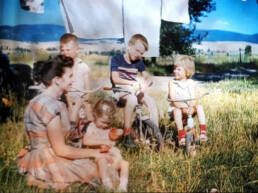
When you first get to the large, white farmhouse, some very vocal geese and ducks make your acquaintance, while friendly cats and dogs await your affections. Their large field, with views of St. Mary’s to the west, is irrigated and leased to local folks. The Gate’s parents, Joseph and Lois, used to grow different crops and had good success raising pigs for a time.
Sam reminisces about simpler times. “There are just so many memories wrapped up in this place,” he said. “All of these things that have tied us together as a family are right here in this place that we grew up. My brother and I chased each other all over these 160 acres.” He motioned to the field, the creek, and the willows, “We were renegades, just running wherever we wanted up and down the creek. We had so much freedom.”
You Can Always Go Home
Life isn’t quite so simple anymore. Children, even rural kids, aren’t as connected to the natural world, playing in fields or running through the trees like Sam and his siblings did. Often they don’t get to spend as much time with other family members like grandparents.
That won’t be the case for this family, or this farm.
“I definitely didn’t want to see this place broken up,” Elizabeth Gates said. “I never would have been able to come back here again if that had happened.” Sam’s daughter Elizabeth and her partner are raising their infant daughter on the farm, carrying on a family tradition. “I cherish the childhood memories I have here, spending precious time with my grandmother.”
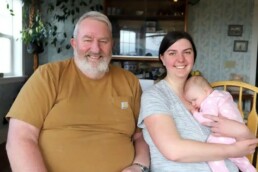
Now four generations of the Gates family have made this farm their home. While his siblings live close by in Missoula, Sam lives on the farm and will see his granddaughter grow up here, run through the same creek, and enjoy the same freedom he felt as a boy.
Sam feels good about the decision to conserve the farm.
“Right from the very first time that we started talking about it, everyone was on board,” he said. “I think my dad is smiling down at us right now and I think mom would be too now that we’ve completed the process. It’s a wonderful thing when you know that you can always go home.”
It’s incredible what happens when we come together to protect this special way of life that is uniquely Bitterroot. This is something we can all be proud of.
It's Something Our Family Feels Good About
Patti Eldredge didn’t plan to become a conservation hero, let alone a community leader. Soft spoken, with wind tussled hair and a bit of whimsy in her smile, she and her husband Howard had lived on their land for years.
The land’s not far from the Bitterroot River, in the town of Victor. The sweeping views stretch out over Sweat House Creek—home to blue herons, eagles and white tail deer.
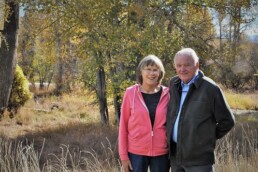
“When we conserved our land, almost twenty years ago, we did it because we really love this place,” she explained. What Patti and Howard didn’t know at the time is that they would end up inspiring more than 35 other families like theirs to conserve their own special lands.
In total, it’s 7,300 acres of some of the Bitterroot Valley’s important ranchlands, wildlife areas, and water ways.
Our Community Need These Lands
“Our community needs these lands,” Patti says. “Enjoying nature, hiking, camping– it’s important to our spiritual, mental, and physical well-being. It would break my heart if we, as a community, lost the special quality of the river, the open spaces.”
That sense of connecting to the land has become part of the Eldredges’ conservation ethic. Over the years they have hosted ecology field trips for elementary students on their place along the creek, so “the kids get a chance to love it, like we do,” she says.
“Too often folks think that you don’t own it, or manage it, when you protect your land, but that’s not the case,” says Patti.
“Conserving your land is a big decision, and for us, we are so thankful we did.”
It seemed like the right thing to do at the time, and it still feels that way almost 20 years later. It’s something our family feels good about. If you treasure this valley, the working lands, the water, the wildlife habitat, then this is the best thing you can do to protect it.”
Access to Nature for All
Skalkaho Bend Park is a treasure of downtown Hamilton.
Through the generosity of the people of the Bitterroot Valley, and in partnership with the City of Hamilton, Skalkaho Bend Park officially opened in summer of 2020.
Click here to download the trail map.

For the Bitterroot community, the new outdoor space to exercise and enjoy nature is the reward for all the local support – contributions, helping hands, encouraging voices, and more – that brought the dream to reality. For all of us at the Land Trust, opening day was the happy conclusion of years of planning, fundraising, building, and working with countless partners to coordinate one of our most ambitious projects ever.
BRLT has paired-up with the Hamilton High School cross-country team to knock-out some noxious weeds at the park.
The runners were excited to volunteer their time removing weeds, getting the park ready for the public.
Sophomore Colter looks up from a patch of knapweed, “We need more land that’s close by for people to use. Having the river run right through is so important.”
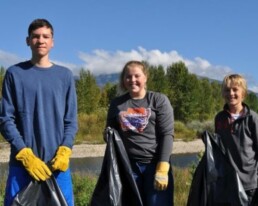
The cross-country team has added the park to their training route because it’s so close to home and school. Team member Jake wants parents and teachers to know, “It’s important to protect lands for the community, being able to bike, fish, run. It’s not always easy for people to get to the river and have access to outdoor activities.”
Creating this park with you – our supporters – is a momentous accomplishment for the entire community. Caring for the land is the next step. If you are interested in volunteering to help with park clean-ups, weeding, and native plantings, please contact our office at 406-365-0956.
“I always want to give back. I’m glad I get the opportunity. I’ve lived outside of Montana, and the truth is, you don’t have places like this–mountains, rivers, nature. We get to run here. It makes you feel lucky and grateful.”
– Cheyenne, Sophomore on the team
And she feels lucky because of you.
Caring supporters like you who make it possible to bring more young people to land and water, in a way that is meaningful to them.
Veterans Have a Place to Reflect
“Along the river, places open to the public can be hard to find,” says Dan Kimzey.
“That’s why I’m so excited this new park will be here for veterans like me to step out of isolation and begin to mend the emotional injuries, grieve those we’ve lost, and find our own paths, by walking here at Skalkaho Bend.”
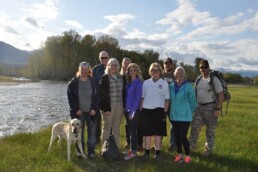
It warms the heart to know that places like the future Skalkaho Bend Park – 70 acres of river bottom, cottonwood galleries, easily accessible trails, flanked by views of the Bitterroot and Sapphire Mountains – can break barriers to nature and bring conservation to more people.
And you make it all possible: nature, close to home, for everyone.
Thanks to you, and so many in our community, Skalkaho Bend Park will be that place for people of all ages and abilities to seek health, joy, and peace for future generations.
Congratulations!
“That’s why I’m so excited this new park will be here for veterans like me to step out of isolation and begin to mend the emotional injuries, grieve those we’ve lost, and find our own paths, by walking here at Skalkaho Bend.”
– Dan Kimzey, retired veteran
Our Small Part
It’s a big sky kind of day. The clouds are on cue, floating overhead in dreamy fashion. In front of landowners Pam and Mark Smithers, the blue and gold sparkle of the West Fork River tumbles by.
Behind them, the rich velvet green forest is in repose. And all around is the song of birds – the rumble of grouse, bald eagle chatter, and honks from Canada geese.
Pam and Mark can’t help but smile at each other. They just recently protected 33 acres of open land at the confluence of Nez Perce creek and the West Fork of the Bitterroot River.
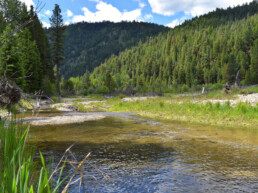
They raised their two boys, Ryan 30 and Will 26, hiking and exploring the wilderness, instilling a love of the outdoors. The natural world has always played a role in the Smithers’ lives, and Montana is where they wanted to be.
“This place in particular, with its views up the Nez Perce drainage, is very special. It was love at first sight! My volunteer work with other land trusts has shown me how powerful conservation easements can be in protecting wild lands for future generations,” says Pam.
The development potential is high due to the desirability of the area with its blue-ribbon fishing and middle-of-nowhere feel. The good news is conservation is making a difference. This stunning half mile of river frontage – with its lush evergreen, cottonwood and aspen forest, beautiful meadow, and wildlife habitat – is protected forever.
“We do worry a bit about the future, but many people are trying very hard to protect the Earth for future generations and we are grateful we can participate in our small way.”
– Pam Smithers
There is still much work to be done. But with thoughtful families like the Smithers, and support from caring community members like you, a future full of beautiful, protected open lands is possible.
A Decision 100% From The Heart
“You know, maybe I’m sacrificing a little bit, but it’s really, really minimal compared to what my grandmother and my dad did before me. They are the ones that held this place together.”
Dan’s eyes twinkled in the warm light of the afternoon sun that shone through tall, oversized windows in his upstairs family room.
You wouldn’t know it now, but for a time this room of the 120-year-old house on Severson’s Flying E Ranch was called “home” by chickens. That was decades ago, when world wars and economic decline took their toll on the Bitterroot Valley. The family, and the ranch, would prove to be stronger than their circumstances.

It was Dan’s grandmother, Toi Long Logan, who spent a life-time caring for the ranch, working hard, and paying off debts, so they wouldn’t lose the land – all the while putting herself and her two daughters through college. After World War II, Dan’s dad came home and got to work rebuilding the ranch right alongside the whole family.
When the ranch was passed down to Dan, he contemplated how to honor their sacrifice and hard work, and secure the future of the ranch.
A Turning Point
Then, in 2006, Ravalli County voters passed the Open Lands bond program which provides funding to conserve water, wildlife habitat, and working farms and ranches.
It was a turning point for Dan. To him, it meant that the people of this valley were willing to come together to protect our beautiful valley and rural way of life. After he and Debbie conserved the ranch in 2011, Dan recalls, “When my neighbors started telling me they were glad about what we did, that meant everything to me.”
Since then, over 7,000 acres have been protected in the Burnt Fork alone. The area includes 15 miles of streams and creeks, varied wildlife habitat for birds, deer and elk, and large amounts of productive hay ground.
For Dan, it was a decision made 100% from his heart.
“The feeling of protecting this place is second only to seeing your kids grow up right. I have four kids—two sons and two daughters – and now it’s possible for this farm to continue for future generations of my family or another family that believes in the importance of agriculture for the community.”
– Dan Severson
While there may still be pressure for some farmers and ranchers to subdivide, it’s because of you – our supporters – the land trust can continue to work with families like the Seversons, and help them figure out if conservation is right for them.
It Will Always Be Here
Not too long ago, a couple hundred acres of hay ground and wild meadows with an uncertain future lay tucked away in the Burnt Fork area of Stevensville. The land was neglected, fences falling down, and the landowners who stewarded this land long ago were a distant memory.
That was until Troy and Dena Griffin found this diamond in-the-rough, and spent a number of years breathing life back into the soil and grasses, repairing fences and irrigation infrastructure.
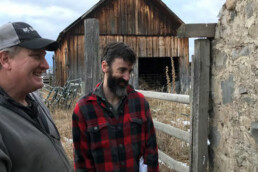
The dream to bring this ranch back to life, some would say, came from an unlikely place. At a young age, the Griffin’s son, Garrett, joined 4-H and fell in love with raising animals and working the land. It became his passion to have his own ranch someday.
More often than not, young people are seeking out careers outside of agriculture, creating uncertainty for many long-standing Montana farms and ranches.
That’s not the case with the Griffin family.
It’s Not Always a Sure Thing
“It’s my son’s dream to have a ranch. The odds of that happening are low. He started 4-H, kept steers at the neighbor’s, and showed them in competition. We wanted that for him. We want to help him fulfill his dream. With help from the land trust and the conservation easement funding, now we can,” Troy smiles warmly.
Now, what was once a big unknown is a sure thing. Garrett is a Bitterroot rancher, and Griffin Ranch is protected, forever.
With resolve in his voice, Troy Griffin softly says, “When we’re gone, it’s over. But if we can leave something that lives on – we’d know that it will always be here. That’s a legacy to leave behind.”
Not only does Griffin Ranch conservation easement fortify the ongoing conservation in the agriculturally and historically significant Burnt Fork neighborhood, it stands as a beacon of hope for the future of Bitterroot Valley farms and ranches, and the young folks who desire to work them.
It's the Reason for Doing It
The cows are relaxing in the sunshine by the barn and there are a few deer browsing down in the draw, out of the wind. Brother and sister, Willis Curdy and Mary Rodriguez are quiet for a moment, gazing across the fields of their family farm in Corvallis.
Mary and brother Willis, grew up farming with their parents Frances and Everett Curdy. There was always something to grow, tend, and prepare for market.
Over the decades, the family has seen its share of good times, hard times, and lots of honest work. Like many farms and ranches in the Bitterroot Valley, over time, it gets harder to continue working the land.
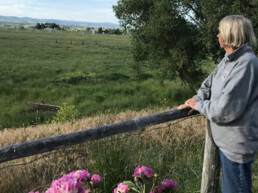
Years ago, mom and daughter ran quite the chicken egg operation, supplying markets, police and fire stations all over the Bitterroot and into Missoula. Mary recalls, “We’d load the eggs the night before, then drive all over hill and dale the next day, delivering about 1,500 eggs. It’s crazy to think we fit all those eggs in that old Dodge Dart station wagon.”
A Family Decision
Many years later, family discussions centered around the future of the farm. Who would work the farm? What will happen to the land when we’re gone? Frances and Everett knew they wanted it to always remain a farm. They knew it should be here for the next generation to work the land. Mary and Willis carried out the family decision to conserve the farm with the land trust.
“We did this for them, saw it through to the end. It’s something we know they wanted. And now, the farm will be here for someone else to farm In the future. That’s the reason for doing it.”
– Mary Rodriguez
Families don’t take these decisions lightly, and often it takes years to go through the conservation easement process. It starts with those early conversations, all the way up to the day it’s complete.
Mary clears her throat, “When my neighbors tell me, ‘I’m happy that you kept the land a farm,’ that means everything to me. My parents worked so hard for that land. And someday a new family will build their life on this farm.”



